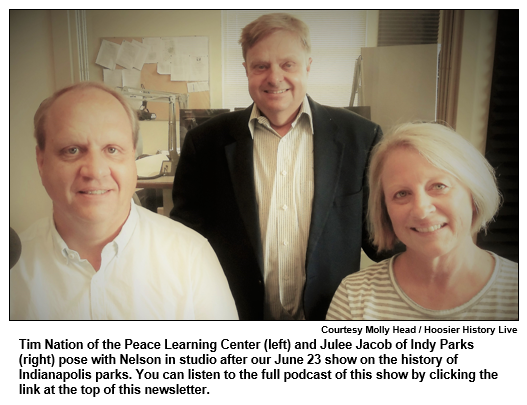Saturdays, noon to 1 p.m. ET on WICR 88.7 FM.
Or listen live from anywhere on WICR Online!
Our call-in number during the show: (317) 788-3314

June 30 2018
Girl Scouts evolution with Deborah Hearn Smith
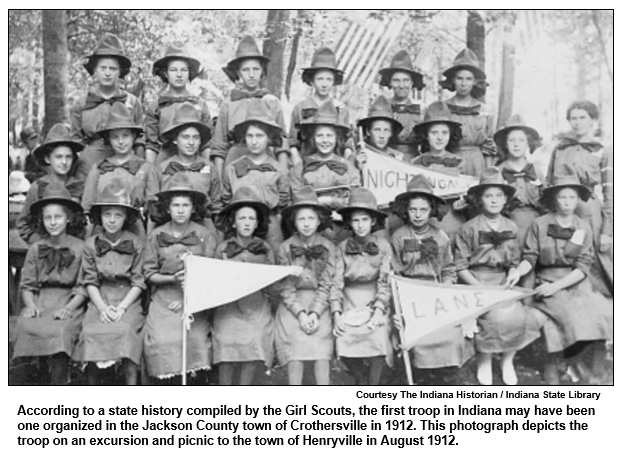
As a 7-year-old student at School 60 on the northside of Indianapolis, she joined a Girl Scout troop at the urging of her mother.

According to a state history compiled by the Girl Scouts, the first troop in Indiana may have been one organized in the Jackson County town of Crothersville in 1912. The historic photo above depicts the troop on an excursion and picnic to the town of Henryville in August 1912. In March of that year, the Girls Scouts in the United States was founded in Savannah, Georgia, by Juliette Low. Earlier in her life, Low had been part of the Girl Guide movement in England.
Our guest Deborah Hearn Smith, a 1966 graduate of Shortridge High School, began as a field executive with the Girl Scouts in 1970, upon graduation from college. She devoted the next 47 years to the Girl Scouts, working on initiatives that engaged girls in science, technology, engineering and math; Deborah was also known for leading the organization's outreach to cultural minorities.
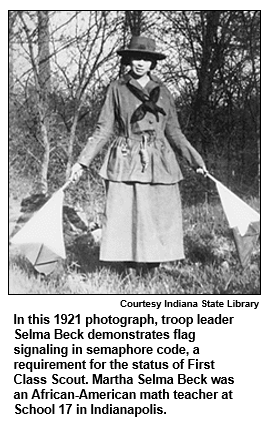
She recently wrote a column for the Indianapolis Business Journal reacting to the decision by the Boy Scouts of America to admit girls. That's among the aspects of scouting's social history we will explore during our show.
Noting that Low included as one of several Girl Scout "laws" the statement that "a Girl Scout is a friend to all, and a sister to every other Girl Scout no matter to what social class she may belong," a history prepared by the organization adds: "Girl Scouting was aimed at all girls, but existing social attitudes shaped the development of scouting among girls of color. It was not until the early 1950s that many campgrounds and troops were integrated."
Even so, diverse Girl Scout troops were organized in Indiana within a decade of the founding of the country's first troop. An African-American troop was active in Indianapolis as early as 1921, according to an account of the organization's evolution here.

In 1936, Girl Scouts from across Indianapolis greeted First Lady Eleanor Roosevelt during her visit to the city. In 1952, a chapter in Gary, Ind., earned national recognition for devoting the most hours of service to a local community.
Also during the 1950s, our guest Deborah Hearn Smith became a Brownie in Indianapolis, where she's been a lifelong resident. Deborah and her husband, Ebenezer Smith, are the parents of two adult sons and have four grandchildren. Her trove of civic honors include the Torchbearer Award from the Indiana Commission for Women and the Women of Influence Award from the Indianapolis Business Journal.
In addition to Deborah, the Indiana Historical Society plans to name as Living Legends civic leaders Leonard Hoops, CEO of Visit Indy; Sallie Rowland, founder of Rowland Design Inc. and the first woman to serve on several corporate boards; and Jeff Smulyan, founder of Emmis Communications Corp. The four Legends will be honored during a gala on July 27 at the Eugene and Marilyn Glick Indiana History Center.
History Mystery
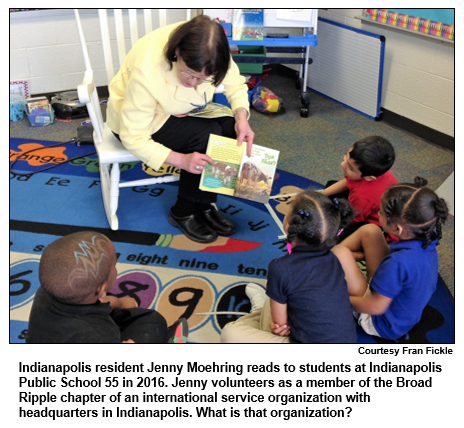
In 1915, three years after Girl Scouts was founded as a national organization and the first troop was formed in Indiana, a non-profit service organization for adults was founded.
The service organization in question began in Michigan, not Indiana, but in the early 1980s, its international headquarters moved to Indianapolis, where it remains to this day on the northwest side of the city. The service organization is international in scope, with chapters in more than 80 countries.
Question: What is the service organization?
Hint: Its name is derived from a word in the Native American Ojibwe language meaning "to fool around; to play wantonly."
The call-in number is (317) 788-3314. Please do not call in to the show until you hear Nelson pose the question on the air, and please do not try to win if you have won any other prize on WICR during the last two months. You must be willing to give your first name to our engineer, you must answer the question correctly on the air and you must be willing to give your mailing address to our engineer so we can mail the prize pack to you. The prize is two tickets to the Seiberling Mansion in Kokomo, courtesy of the Howard County Historical Society, two passes to GlowGolf, courtesy of Glowgolf, and two passes to the Indiana History Center, courtesy of the Indiana Historical Society.
Roadtrip: Terre Haute, "Town of Museums"

Guest Roadtripper David Buchanan, Curator of Furnishings and Decorative Objects at the Indiana State Museum and Historic Sites, will be calling in from Terre Haute with a whirlwind tour of the city's museums and top spots of visitor interest. David tells us that Terre Haute is a three-university town with several great museums, including the Candles Holocaust Museum, Swope Art Museum, the Children's Museum, the Clabber Girl Museum in the original Hulman and Company building, and the Eugene V. Debs home.
David also suggests a visit to some very nice city parks, including Hawthorn Park and its Smith Memorial Labyrinth, modeled after the labyrinth in the Chartres Cathedral in France.
If local cuisine is your interest, did you know that the Square Donut had its birth in Terre Haute? And speaking of sweet treats, you won't want to miss the Vigo County Historical Society Museum's marvelous display of Coca Cola-related memorabilia; the iconic Coke contoured glass bottle was designed by the Root Glass Company of Terre Haute.
And if you're in the mood for a spooky ghost story, you can visit the museum's stuffed bulldog, Stiffy Green, and learn how the canine's love for his master ostensibly transcended the grave. But a little delayed gratification will be required; the Vigo County Historical Society Museum is currently closed and scheduled to reopen in early 2019. You can keep an eye on their progress by visiting their website.
Meanwhile, Terre Haute's many other attractions will keep you busy on your visit to Indiana's "capital of the Wabash Valley."
Nelson took us for a walk in the park (Indy Parks, that is)
Nelson Price, host and historian
Molly Head, producer/project manager, (317) 927-9101
Michael Armbruster, associate producer
Cheryl Lamb, administrative manager
Richard Sullivan, senior tech consultant
Pam Fraizer, graphic designer
Garry Chilluffo, special events consultant
Please tell our sponsors that you appreciate their support!

 Acknowledgments to Monomedia, Visit Indy, WICR-FM, Fraizer Designs, Heritage Photo & Research Services, Henri Pensis, Chris Shoulders and many other individuals and organizations. We are an independently produced program and are self-supporting through organizational sponsorship, and by individual contribution which can easily be made at the yellow button on our newsletter or website. For organizational sponsorship, which includes logos, links, and credits in the show, contact Molly Head at (317) 927-9101 or email her at molly@hoosierhistorylive.org. Any of our podcasts can be sponsored for a nominal fee as we gear up for online distribution.
Acknowledgments to Monomedia, Visit Indy, WICR-FM, Fraizer Designs, Heritage Photo & Research Services, Henri Pensis, Chris Shoulders and many other individuals and organizations. We are an independently produced program and are self-supporting through organizational sponsorship, and by individual contribution which can easily be made at the yellow button on our newsletter or website. For organizational sponsorship, which includes logos, links, and credits in the show, contact Molly Head at (317) 927-9101 or email her at molly@hoosierhistorylive.org. Any of our podcasts can be sponsored for a nominal fee as we gear up for online distribution.
Thank you!
We'd like to thank the following recent, new and renewal contributors whose donations help make this show possible!
- Daniel Craig
- In memory of Elizabeth Meyer Strain Gunn by Roz Wolen
- Margaret Smith
- Stacia Gorge
- Robin Jarrett
July 7, 2018 - Upcoming
Ellis Island, immigration and Indiana

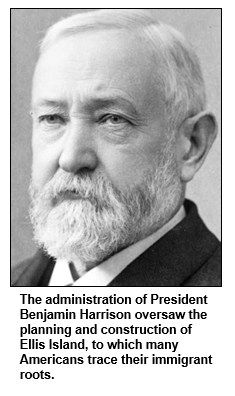
The receiving station for aspiring Americans now celebrated as an iconic aspect of our shared history opened on Ellis Island in 1892 during the administration of President Benjamin Harrison, so the only president elected from Indiana oversaw the lead-up to its debut. According to some estimates, about 22 million immigrants passed through Ellis Island during the years between 1892 and 1924, its peak period as the country's "door." (Ellis Island remained open as a receiving center until 1954, but during its final 30 years, limitations on immigration - and the creation of other points of entry - meant that far fewer immigrants were handled at the island.)
Not only will we explore the challenges that confronted all involved during the early Ellis Island years - immigrants often endured shockingly crude medical exams - we also will look at the waves of ethnic heritage groups that came to Indiana from the 1890s through the mid-1920s. Nelson's studio guests will be:
- Jennifer Capps, the veteran curator at the Benjamin Harrison Presidential Site in Indianapolis. Because Ellis Island opened under the Harrison administration - he was elected president in 1888 and left office in early 1893 - Jennifer has researched several aspects of the planning for the major immigrant processing center. According to Ellis Island: Gateway to the American Dream (Barnes & Noble Books, 1998), "the federal government assumed responsibilities for immigration and built Ellis Island" after corruption scandals with its predecessor, Castle Garden, which was run by New York officials.
- And Teresa Baer, managing editor of the Indiana Historical Society Press. Teresa is the author of Indianapolis: A City of Immigrants (2012) and Finding Indiana Ancestors (2007), both published by the IHS Press; she also is the editor of The Hoosier Genealogists: Connections, the society's family history magazine.
According to timelines in Teresa's books and in other reference sources, the 1890s through the early 1900s in Indiana was an era of heavy immigration from Eastern European countries including Poland, Hungary and Russia, as well as such Mediterranean countries as Greece and Italy. Significant percentages of the immigrants were Catholic and Jewish.
During our show, we will frame the early decades of immigration through Ellis Island by describing the waves of ethnic immigration to Indiana that preceded it, including early Irish, German, English and Scottish arrivals.
Some history facts:
- The first site proposed for the immigrant processing station was Bedloe Island (now called Liberty Island), where construction on the Statue of Liberty had been completed just a few years prior, in 1886. Because of public opposition to that proposal, nearby Ellis Island was chosen instead.
- The first official to climb to the top of the Statue of Liberty was Harrison's vice president, Levi P. Morton.
- As recently as 1997, more than 40 percent of the U.S. population could "trace their roots to an ancestor who came through Ellis Island," according to the Statue of Liberty-Ellis Island Foundation.
© 2018 Hoosier History Live. All rights reserved.
|

